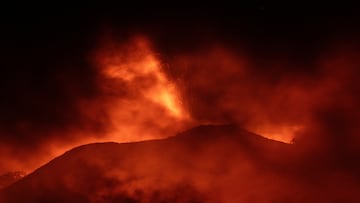NATURE
What and where are the largest active volcanoes in the world?
Volcanoes around the globe continue to capture attention, prompting many to question where the biggest ones are.

The volcano on Ruang Island, which is part of the Sangihe Islands in northern Indonesia, erupted this week, increasing the interest once again on the crust ruptures on our little planet Earth. This one, where the peak reaches around 2,400 feet, comes on the back of that in the small town of Grindavik, Iceland, at the end of last year, and that of the famous Mount Etna, which was active again.

What are the ten largest volcanoes on Earth?
Etna, the tallest volcano in Europe located on the island of Sicily, is one of the most active in the world in an “almost constant state of activity.” This has made it a tourist attraction drawing the attention of volcano enthusiasts from all over the world who are amazed by the beauty of nature’s force. Mount Etna is number six on the list of the ten tallest volcanoes.
Four of the ten largest volcanoes in the world, are currently erupting. They include Mayon in the Philippines, Popocatepetl in Mexico and Semeru in Indonesia.
And while most of the volcanoes on the list have come to life on numerous occasions in recent centuries, one has been silent for 360,000 years.
Kilimanjaro in Tanzania has three volcanic peaks and the tallest, Kibo, is currently dormant but volcanologists believe that it could possibly erupt again, but it is unlikely to do so anytime soon. However, if activity picked up under the surface, there exists the possibility that the mountain could collapse in on itself.
Many of the largest active volcanos can be found along a region called the “Ring of Fire,” which creates the outer border of the Pacific Ocean. This area is known for volcanos and higher levels of seismic activity more prone to earthquakes. It runs from Antartica in the south, up through New Zeland, the Indonesian archipelago, Japan and the Kamchatka peninsula in the east of Russia. Then across the Aleutian Islands of Alaska over to the west coast of North America continuing down along Central American and South America and back to Antartica to complete the ring.
The ten largest volcanoes in terms of height:
- Mauna Loa - United States
- Mount Kilimanjaro - Tanzania
- Popocatépetl - Mexico
- Mount Fuji - Japan
- Mount Semeru - Indonesia
- Etna - Italy
- Mount St Helens - United States
- Mayon Volcano - Philippines
- Mount Bromo - Indonesia
- Arenal Volcano - Costa Rica
Plate tectonics keep our planet evolving all the time and while most of the tallest volcanoes are hundreds of thousands of years old, the Arenal Volcano in Costa Rica is believed to be a mere 7,000 years old. The world’s youngest popped out of a cornfield in Paricutin, Mexico in 1943. Over nine years of eruptions it formed a cone nearly 1,400 feet high and swallowed up two towns in the process.





